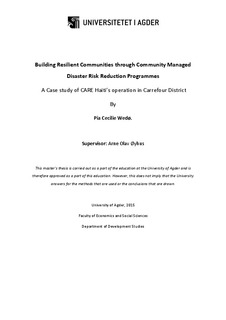| dc.description.abstract | The connections between natural hazards, natural disasters and human vulnerabilities have become
common features of disaster risk reduction (DRR) programmes since the adoption of The Hyogo
Framework for Action (HFA) 2005–2015. A series of international initiatives have begun to prioritize
social vulnerability and community managed disaster risk reduction (CMDRR) in order to enhance the
capacity of disaster-affected communities to recover from a disaster with little or no external
assistance.
This thesis explores whether, and to what extent, CARE can strengthen the capacity of Haitians to
promote resilient communities through Community Managed Disaster Risk Reduction (CMDRR)
programmes, and to see if such programmes can generate sustainable development. The thesis
investigates what the underlying vulnerabilities are, through the Pressure and Release (PAR) model,
whilst also taking into account the particular historical and political context in Haiti. Vulnerability is
evaluated in the three levels: root causes, dynamic pressure and unsafe conditions on the social side.
The component on the natural side is the 2010 earthquake itself. The CMDRR process are analysed by
applying Cordaid’s (2009) four components of DRR: 1) risk assessment and analysis; 2) DRR measures:
developing contingency and development plans; 3) self-organization; and 4) participatory monitoring,
evaluation and learning system. I also address the relationship between International nongovernmental
organization (INGOs) and the community members in general, and the relationship
between CARE and the community members in particular.
The research draws on qualitative data, mainly from in-depth interviews, focus group discussions
(FGDs) and participant observation of the CMDRR process. My findings suggest that people can
possess characteristics that make them both vulnerable and resilient. The CMDRR process made the
community members resilient in the sense that it had increased their awareness and knowledge
capacity in regards to natural disasters, disaster-resilient construction and climate change. The
women in La Grenada also felt empowered after the CMDRR process, and used their knowledge to
educate the wider community. The CMDRR workshops had strengthened community ties, both within
the community and with neighbouring communities. Despite human progress, the opportunities
brought through the CMDRR process is not able to contribute to the long-term prosperity. Consistent
with the PAR model and the numerous vulnerabilities identified, my findings suggests that resilience
building is about good governance: it is primarily and fundamentally political, with its success
depending on citizen power, genuine participation and a good relationship between the INGOs, the
Haitian population and the government. As such, building resilient communities involves something
more from simply dealing with preparedness measures through CMDRR interventions. | nb_NO |
